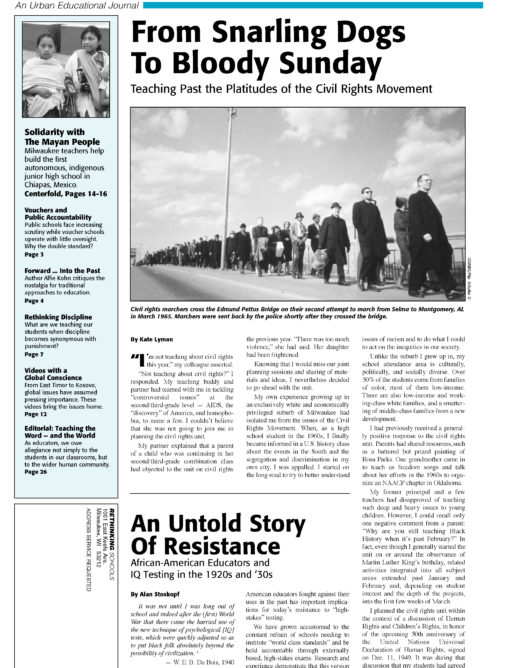Preview of Article:
Forward…Into the Past
Let us begin by acknowledging that there are as many ways of teaching as there are teachers. Anyone who attempts to apply a single set of labels to all educators will be omitting some details and ignoring some complications – not unlike someone who describes politicians in terms of how far they are to the left or right. Still, it isn’t entirely inaccurate to classify some classrooms and schools, some people and proposals, as tilting toward a philosophy that is more traditional or conservative as opposed to nontraditional or progressive. The former might be called the Old School of education, which of course is not a building but a state of mind – and ultimately a statement about the mind.
When asked what they think schools ought to look like, some back-to-basics proponents cite the importance of “obedience to authority” and list certain favored classroom practices: “Students sit together (usually in rows) and everyone follows the same lesson. … In basics classrooms lines of responsibility are very clear; everyone knows his or her task and recognizes who is in charge.” The idea is to have students memorize facts and definitions, to make sure that skills are “drilled into” them. Even in social studies, as one principal explains, “We are much more concerned about teaching where Miami is than about Miami’s problem with Cubans.”2 Not all traditionalists would go quite that far, but most would agree that schooling amounts to the transmission of a body of knowledge from the teacher (who has it) to the child (who doesn’t), a process that relies on getting the child to listen to lectures, read textbooks, and, often, to practice skills by completing worksheets.
In the Old School, reading lessons tend to teach specific sounds, such as long vowels, in isolation; math classes emphasize basic facts and calculations. Academic fields (math, English, history) are taught separately. Within each subject, big things are broken down into bits, which are then taught in a very specific sequence. The model also tends to include traditional grades, plenty of tests and quizzes, strict (punitive) discipline, competition, and lots of homework. Anything that deviates from this model is often reviled as a fad, with special scorn reserved for efforts to teach social skills or address students’ feelings, to have students learn from one another, to use nontraditional ways of assessing what they can do, as well as to adopt bilingual education, a multicultural curriculum, or a structure that brings together students of different ages or abilities.
Nontraditional or progressive education is defined in part by its divergence from all of this. Here, the point of departure is that kids should be taken seriously. Because learning is regarded as an active process, learners are given an active role. Their questions help to shape the curriculum, and their capacity for thinking critically is honored even as it is honed. In such classrooms, facts and skills are important but not ends in themselves. Rather, they are more likely to be organized around broad themes, connected to real issues, and seen as part of the process of coming to understand ideas from the inside out. A classroom is a place where a community of learners – as opposed to a collection of discrete individuals – engages in discovery and invention, reflection and problem-solving.
These aspects of progressive education have been around for a very long time. For centuries, children learned by doing at least as much as by listening. Hands-on activities sometimes took place in the context of a mentor-apprentice relationship and sometimes in a one-room schoolhouse with plenty of cooperative learning among kids of different ages. Many aspects of the Old School, meanwhile, really aren’t so old: “The isolated skills approach to learning,” for example, “was, in fact, an innovation that started in the 1920s.”3</p

